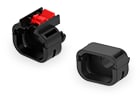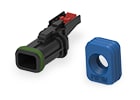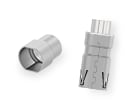DT Highspeed Connectors housings
Frequently Asked Questions
DT Highspeed Connectors housings
Q: What makes DT highspeed connector housings different from standard connector housings?
A: DT highspeed connector housings are built for wire-to-wire high-speed data applications, offering IP-rated environmental sealing, keyed alignment for secure mating, and a 60V DC / 48V AC rating. Their rugged design supports high-vibration and extreme-temperature environments, making them suited for industrial and commercial vehicles.
Q: Can these connector housings be used in high-vibration environments?
A: Yes! These housings are designed with keyed mating alignment and integrated locking features to help prevent accidental disconnection in off-highway vehicles, construction machinery, and mining equipment.
Q: Are DT highspeed connector housings compatible with existing DEUTSCH DT connectors?
A: Absolutely! These housings use DEUTSCH DT connector-style interfaces, allowing seamless integration with existing DEUTSCH connector systems and harnessing tools, helping to reduce installation time and costs.
DT Highspeed Connectors headers
Frequently Asked Questions
DT Highspeed Connector headers
Q: How do DT highspeed connectors help with automotive Ethernet applications?
A: DT highspeed connectors are designed for high-speed data transmission, making them well-suited for ADAS, RADAR, LiDAR, and fleet telematics. With up to 40m channel length, they help reduce signal loss, improving vehicle-to-vehicle (V2V) and vehicle-to-infrastructure (V2I) communication.
Q: Can these connectors be used in off-highway and construction vehicles?
A: Yes! These connectors are built for rugged applications, featuring IP67/IP69K sealing and USCAR2 V1 vibration resistance. This makes them reliable for mining, construction, and heavy equipment, where dust, moisture, and extreme temperatures are a concern.
Q: How do DT highspeed connectors compare to traditional automotive connectors?
A: Unlike standard connectors that support only 15m channel lengths, DT highspeed connectors extend up to 40m while maintaining signal integrity. They also offer enhanced environmental sealing, making them more suitable for industrial and commercial vehicles.
DT Highspeed Connectors backshells
Frequently Asked Questions
DT Highspeed Connectors Backshells
Q: What is the purpose of the DT Highspeed connector backshell?
A: The DT highspeed connector backshell is designed to be used with DT highspeed connectors, featuring a 180° cable exit for structured wiring applications in industrial and automotive environments.
Q: What material is the backshell made from?
A: The backshell is constructed from PBT (Polybutylene Terephthalate), a thermoplastic material that is known for its durability and temperature resistance.
Q: What temperature range can this backshell handle?
A: The backshell is rated for operation in temperatures ranging from -40°C to 125°C (-40°F to 257°F), making it suitable for various industrial and automotive applications.
DT Highspeed Connectors seals and plugs
Frequently Asked Questions
DT Highspeed Connectors seals and plugs
Q: What is the purpose of DT highspeed connector seals & plugs?
A: These seals and plugs help protect high-speed connectors from moisture, dust, and contaminants, contributing to long-term connection stability in demanding environments.
Q: What material are these seals and plugs made from?
A: They are constructed from VMQ silicone rubber, known for its flexibility, durability, and excellent resistance to hydrocarbons, oils, and fuels.
Q: What size cavities do these seals and plugs fit?
A: They are designed for 6mm cavity diameters and accommodate wire insulation diameters between 6.5mm and 7mm.
DT Highspeed Connectors shielding
Frequently Asked Questions
DT Highspeed Connector shielding
Q: What is the purpose of DT highspeed connector shielding?
A: This shielding accessory helps reduce electromagnetic interference (EMI) and enhance signal integrity for high-speed DT highspeed connectors, making it suitable for automotive and industrial environments.
Q: What material is the shielding ferrule made from?
A: The DT highspeed connector shielding is constructed from copper alloy, which provides durability, electrical conductivity, and mechanical strength.
Q: Is this shielding accessory suitable for extreme temperatures?
A: Yes, it is rated for -40°C to 125°C (-40°F to 257°F), making it reliable in both high-heat and freezing environments.






